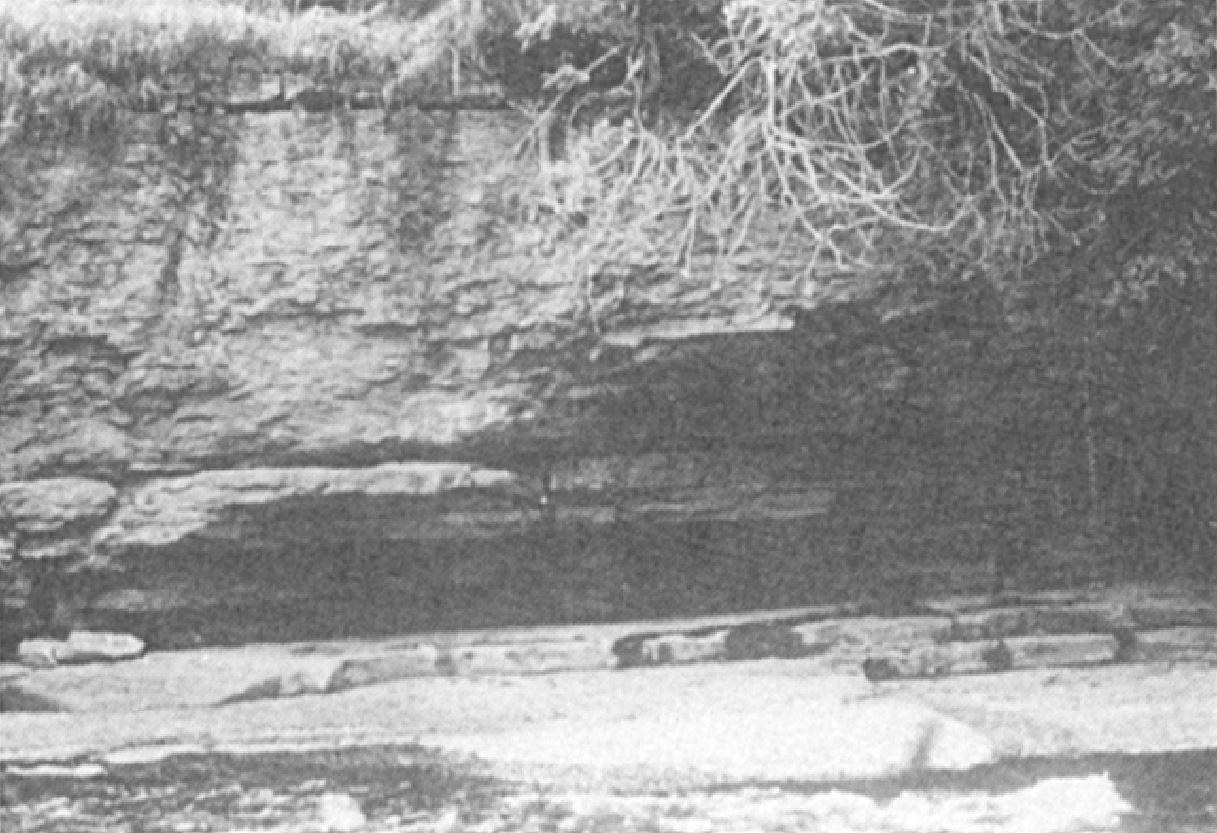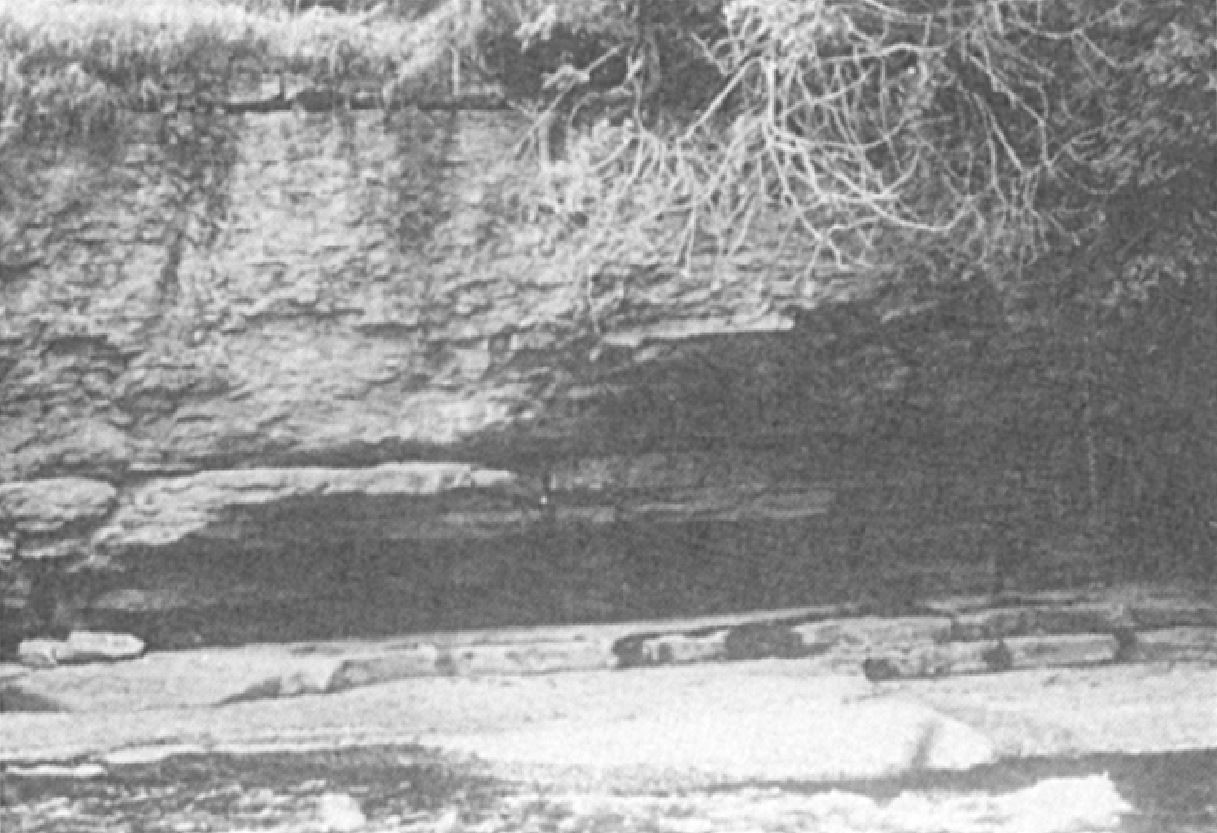
DISCLAIMER: This English version is translated from the original French. In case of any discrepancy, the French version shall prevail.
| Author: | Okulitch, 1939 |
| Age: | Middle Ordovician |
| Stratotype: | Type section described by Clark and Globensky (1976b) on the left bank of the Ouareau River, immediately upstream of the Road 158 (formerly Road 41) bridge near Crabtree; sections described by Clark and Globensky (1976a) in NE Joliette Hill, 0.5 km SE of the Grande-Chaloupe Range parallel to the La Chaloupe River, and along a small road that descends towards the La Chaloupe River, 800 m west of the Road 158 bridge, ~4 km south of Sainte-Élizabeth |
| Type area: | Ouareau River area (NTS sheet 31H13) |
| Geological province: | St. Lawrence Platform |
| Geological subdivision: | St. Lawrence Lowlands Platform |
| Lithology: | Micritic and nodular limestone, argillaceous; shale |
| Category: | Lithostratigraphic |
| Rank: | Formation |
| Status: | Formal |
| Use: | Active |
- Trenton Group
- Tétreauville Formation
- Montréal Formation
- Neuville Formation
- Deschambault Formation
- Hull Formation
- Saint-Marc Formation
- Ouareau Formation
- Fontaine Formation
- Pont-Rouge Formation
- Mile End Formation
- Sainte-Anne Formation
- Galets Formation
- Shipshaw Formation
- Simard Formation
- Tremblay Formation
- René-Levasseur Formation
Background
Okulitch (1939) noticed on the Ouareau River a section of interstratified beds containing fauna typical of the Trenton and Black River groups. He called this section the “Ouareau transition zone.” Husain (1955) related the lithology to the Trenton Group. Clark (1959) considered this unit contemporaneous to the Hull Formation. Clark and Globensky (1976a, b) affirmed that the abrupt fauna distinction between the Ouareau Formation and the underlying Leray Formation (Black River Group) and the marked colour difference between the Ouareau and overlying Deschambault formations were sufficient to define a distinct formation: the Ouareau Formation.
Description
The Ouareau Formation consists of dark grey micritic limestone, irregularly bedded (with strong external undulations) and thin-bedded (7-15 mm), nodular, argillaceous and interstratified with shale (Clark and Globensky, 1972, 1976a, b; Brun, 1974, 1975; Harland and Pickerill, 1982; Globensky, 1983, 1986, 1993; MNRF, 2009a, b, c; Thériault, 2014). Shale and most limestone beds are bioturbate (abundance of gastropod and ostracod bioclasts) although locally they appear laminated or cross-bedded. Brown (1974, 1975) noted the presence of disseminated mineralization of pyrite and more locally of sphalerite, but mainly of brown or white calcite eyes. Clark and Globensky (1976b) described a type section of the Ouareau Formation on the left bank of the Ouareau River, immediately upstream of the Road 158 bridge (formerly Road 41) near Crabtree:
| Deschambault Formation | Base of the Deschambault Formation, immediately downstream of the bridge | |
| Ouareau Formation | More or less massive assemblage of irregularly bedded, finely crystalline to dense, dark limestone. With the 1.42 m unit below, it forms an overhanging cliff immediately downstream of the bridge. Stromatocerium. Other fossils are sparse. Bed I of the generalized section. | 2.29 m |
| Finely fragmented limestone with several gasteropod-rich zones, and other fossils. Beds 5-15 cm thick. Large collections of fossils were sampled from the debris at the base of the overhanging cliff. | 1.42 m | |
| Dense limestone bed. Bed G of the generalized section. | 0.10 m | |
| Irregularly bedded fragmented limestone with a brownish shale network. | 0.15 m | |
| Pure limestone bed. | 0.15 m | |
| Irregularly bedded fragmented limestone with a brownish shale network. | 0.13 m | |
| Pure limestone bed. | 0.08 m | |
| Prominent bed of finely crystalline to dense limestone, dark bluish grey, composed of three thinner islets. | 0.25 m | |
| 4.57 m |
In the NE part of Joliette Hill, 0.5 km SE of the Grande-Chaloupe Range parallel to the Chaloupe River, there was a clearing (now occupied by the Turnbull Quarry which exploits limestone of the overlying Black River Group) where there are discontinuous outcrops that can define a section at the base of which the Ouareau Formation is found (Clark and Globensky, 1976a):
| Deschambault Formation | Fine to medium-grained brownish grey crystalline limestone. | 0.25 m |
| Fine-grained and thin-bedded crystalline limestone. | 0.30 m | |
| Fine grained brownish dark grey limestone. Chert. | 0.56 m | |
| Ouareau Formation | Fine grained dark grey limestone. | 0.25 m |
| Entirely crystalline limestone. | 0.51 m | |
| Entirely crystalline limestone. | 0.61 m | |
| Dense, semi-lithographic, brownish grey limestone containing numerous irregular veins of crystalline calcite. | 0.46 m | |
| No outcrop. | 0.84 m | |
| Fine grained brownish dark grey limestone. Abundant gasteropods. Other types of fossils are sparse. | 0.23 m | |
| 4.01 m |
Approximately 4 km south of Sainte-Élizabeth and 800 m west of the bridge across the La Chaloupe River, a section can be constructed from a few outcrops staggered along a small road down the river (Clark and Globensky, 1976a):
| Ouareau Formation | Top of the section. | |
| Fine-grained dark limestone containing some large calcite crystals. Numerous small gasteropods. | 1.83 m | |
| Very fine-grained, almost sublithographic limestone, altering to white. | 0.30 m | |
| Fine-grained dark crystalline limestone. | 0.91 m | |
| Very fine-grained dark crystalline limestone. Chert. | 0.30 m | |
| Very fine-grained dark crystalline limestone, containing a thin bed of coarse-grained crystalline rocks. | 1.22 m | |
| Fine-grained dark crystalline limestone, in part sublithographic. Abundant small gasteropods. | 0.61 m | |
| 5.17 m |
From five sections (Miron Ltd. Company Quarry, Montreal; St-Vincent de Paul Quarry, St-Vincent-de-Paul; Sintra Quarry, St-Jacques; Ciments Indépendants Inc. Quarry, Joliette; Turnbull Construction Inc. Quarry, St-Thomas), Brun (1974, 1975) defined boundary stratotypes between the Leray (Black River Group), Ouareau and Mile End formations: “Leray-Ouareau boundary: Sharp transition from a small bed of very dark grey siliceous ‘mudstone’ limestone with many white calcite eyes and disseminated mineralization of brown calcedony (Leray) to alternating small, wavy beds of massive ‘mudstone’ limestone and beds of black grey schistose argillite containing gastropods (Ouareau). Ouareau-Mile End boundary: Transition from alternating small, very wavy beds of massive ‘mudstone’ limestone with calcite eyes and beds of black grey schistose argillite containing gastropods (Ouareau) to a very large ‘wakestone’ limestone bed with numerous internal discontinuous undulations (Mile End).”
Thickness and distribution
The Ouareau Formation reaches a thickness of 6 m north of Montreal, but generally ranges from 4 to 5 m (Clark and Globensky, 1976a, b; Globensky, 1993). It outcrops mainly in the Joliette area along a thin N-S to NE-SW strip (<500 m wide) for nearly 50 km, between Sainte-Anne-des-Plaines and Joliette (north of sheet 31H12, sheet 31H13 and SW corner of sheet 31I03). It extends for about 12 km NE of Joliette in the Saint-Thomas area (SW quarter of sheet 31I03).
Dating
None.
Stratigraphic Relationship(s)
Because of its stratigraphic position, Harland and Pickerill (1982) correlates the Ouareau Formation with the Fontaine, Pont-Rouge, Mile End and Sainte-Anne formations, as all these formations represent basal units of the Trenton Group, overlying the Leray Formation (Black River Group) and in contact with the overlying Deschambault Formation. The Ouareau Formation is generally in discordance with the underlying Leray Formation and the overlying Deschambault Formation. However, the Ouareau Formation is separated from the Deschambault Formation by the Mile End Formation on several sections established in careers of the Montreal and Joliette areas (Brun, 1974, 1975).
Paleontology
The restricted fauna of the Ouareau Formation is somewhat similar to that of the Black River Group, but extensive sampling has allowed this formation to be associated with the Trenton Group (Husain, 1955; Clark and Globensky, 1976a, b; Globenski, 1987, 1993). Thus, Foerstephyiium and Stromatocerium are associated with the Leray and Ouareau formations, while Sowerbyella sericea and Paucicruara rogata are associated with the Trenton Group.
References
Publications Available Through SIGÉOM Examine
BRUN, J. 1974. ETUDE PETROGRAPHIQUE DES FORMATIONS DU BLACK RIVER ET DU TRENTON DU QUEBEC. MRN. DP 248, 24 pages and 4 plans.
BRUN, J. 1975. ETUDE GEOLOGIQUE ET GEOCHIMIQUE DES FORMATIONS DU BLACK RIVER ET DU TRENTON DU QUEBEC. MRN. DP 296, 45 pages and 4 plans.
CLARK, T H., GLOBENSKY, Y. 1972. FINAL REPORT ON THE GEOLOGY OF THE SOREL MAP AREA. MRN. DP 200, 205 pages and 1 plan.
CLARK, T H., GLOBENSKY, Y. 1976a. REGION DE SOREL ET PARTIE SUD-EST DE SAINT-GABRIEL-DE-BRANDON. MRN. RG 155, 166 pages and 1 plan.
CLARK, T H., GLOBENSKY, Y. 1976b. REGION DES LAURENTIDES (MOITIE EST) ET DE RAWDON (PARTIE SUD-EST). MRN. RG 157, 121 pages and 1 plan.
GLOBENSKY, Y. 1983. REGION DES LAURENTIDES (SW). MRN. MM 82-01, 42 pages and 1 plan.
GLOBENSKY, Y. 1986. GEOLOGIE DE LA REGION DE SAINT-CHRYSOSTOME ET DE LACHINE (SUD). MRN. MM 84-02, 182 pages and 2 plans.
GLOBENSKY, Y. 1987. GEOLOGIE DES BASSES-TERRES DU SAINT-LAURENT. MRN. MM 85-02, 71 pages and 1 plan.
GLOBENSKY, Y. 1993. LEXIQUE STRATIGRAPHIQUE CANADIEN – VOLUME V-B – REGION DES APPALACHES, DES BASSES-TERRES DU SAINT-LAURENT ET DES ILES DE LA MADELEINE. MRN. DV 91-23, 336 pages.
MRNF 2009a. COMPILATION GÉOLOGIQUE, 31H13 – LAURENTIDES. In : MRNF. 2010. CARTE(S) GÉOLOGIQUE(S) DU SIGEOM – feuillet 31h. CG SIGEOM31H, 22 plans.
MRNF 2009b. COMPILATION GÉOLOGIQUE, 31H14 – VERCHÈRES. In : MRNF. 2010. CARTE(S) GÉOLOGIQUE(S) DU SIGEOM – feuillet 31h. CG SIGEOM31H, 22 plans.
MRNF 2009c. COMPILATION GÉOLOGIQUE, 31I03 – SOREL. In : MRNF. 2010. CARTE(S) GÉOLOGIQUE(S) DU SIGEOM – feuillet 31i. CG SIGEOM31M, 16 plans.
THERIAULT, R. 2014. GEOLOGIE DES BASSES-TERRES DU SAINT-LAURENT. MERN. DV 2014-05, 1 plan.
Other Publications
CLARK, T.H. 1959. Stratigraphy of the Trenton Group, St. Lawrence Lowlands, Quebec. Geological Association of Canada; proceedings 1959, pages 13-21.
HARLAND, T.L., PICKERILL, R.K. 1982. A review of Middle Ordovician sedimentation in the St. Lawrence Lowland, eastern Canada. Geological Journal; volume 17, pages 135-156. https://doi.org/10.1002/gj.3350170205
HUSAIN, B.R., 1955. Semi-microfossils of the Black River and Trenton Groups of Quebec. Doctoral thesis, Université McGill, Montréal, 429 pages.
OKULITCH, V.J. 1939. The Black River Group in the region between Montreal and Quebec. American Journal of Sciences; volume 237, pages 81-93.



